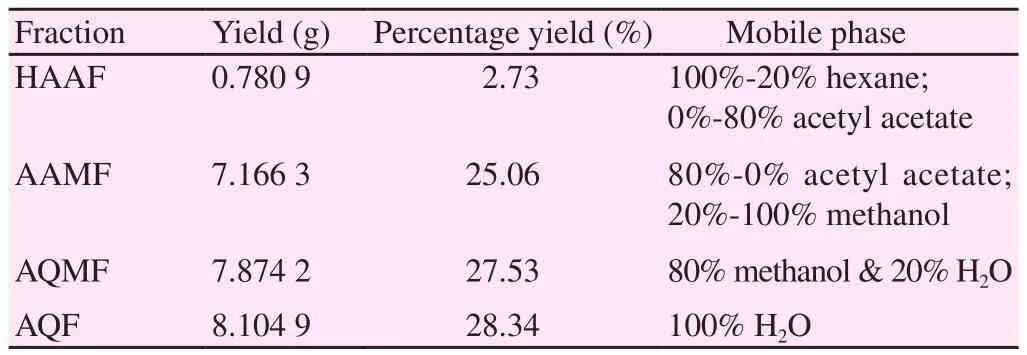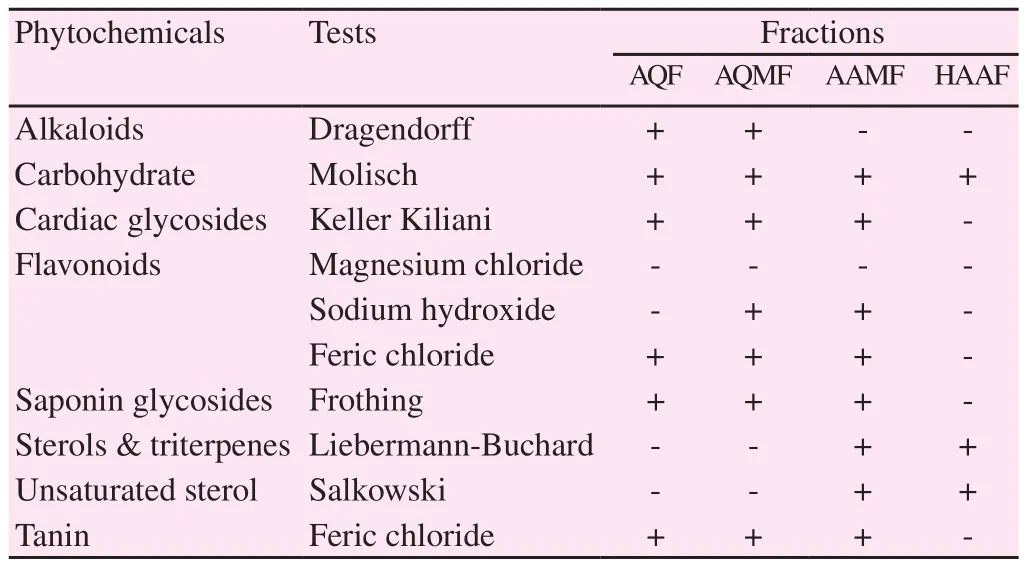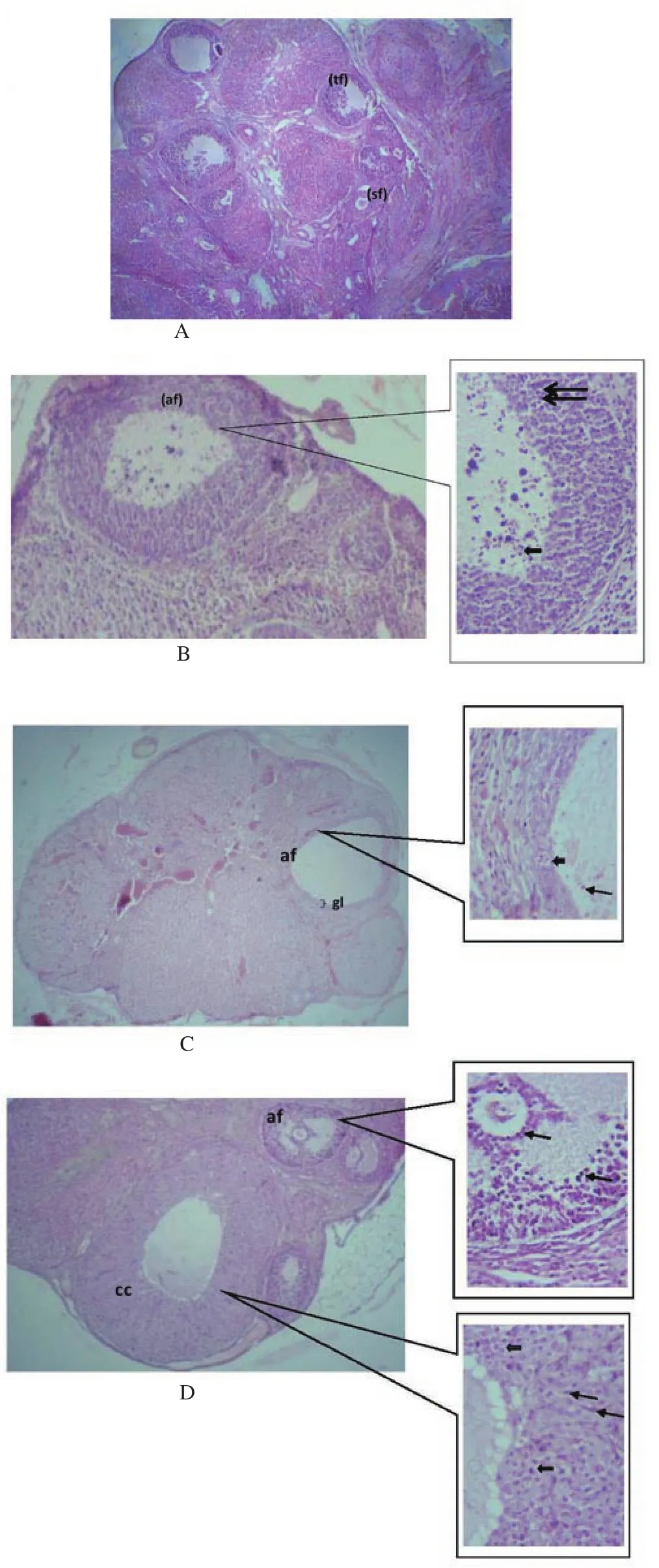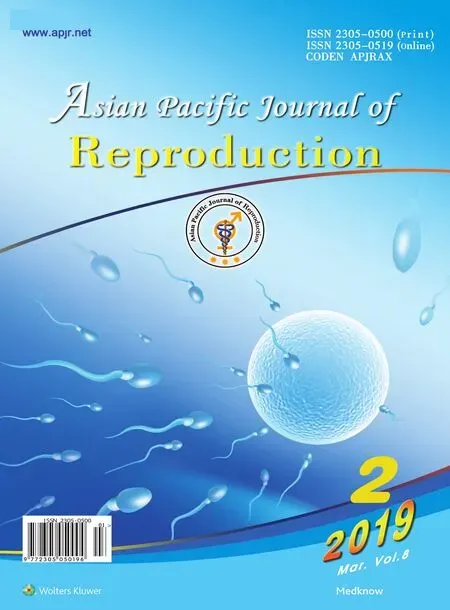Oestrous cycle of Wistar rats altered by sterol and triterpenes rich fraction of Adansonia digitata (Linn) root bark - A scientific rationale for contraceptive use
Chibuogwu Ijeoma Chika, Nwannenna Agnes Ifeyinwa, Ubah Simon Azubuike, Ogwu David
1Department of Theriogenology and Production, Ahmadu Bello University, Zaria, Kaduna State, Nigeria
2Department of Theriogenology, Faculty of Veterinary Medicine, University of Abuja, Federal Capital Territory, Nigeria
Keywords:Proestrus Diestrus Adansonia digitata (Linn)Root bark Contraception
ABSTRACT Objective: To investigate the effect of different fractions from the aqueous methanolic root bark of Adansonia digitata (Linn) on the estrous cycle of female Wistar rats and to elucidate their phytochemical content.Methods: Crude aqueous methanol extract of Adansonia digitata (Linn) root bark was fractionated by column chromatography using various ratios of hexane, acetyl acetate,methanol and distilled water. Fractions with similar trails on a thin layer chromatography were pooled into four fractions. Each fraction was then screened for its phytochemical content.Forty mature Wistar female rats weighing (135±28) g with regular estrous cycles were given each fraction at two dose levels while a control group received distilled water of equal volume.Treatments were given per os for 15 days starting from the day of estrus. Vaginal smears were observed daily for the duration of each cycle, frequency of occurrence of each stage of the estrous cycle and number of cycles for 15 days before and during treatment. At the end of treatment, rats were humanely sacrificed. Ovaries and uteri were weighed and processed for histopathology.Results: Hexane acetyl acetate and acetyl acetate methanol fractions at 150 mg/kg body weight and 300 mg/kg body weight prolonged the occurrence of proestrus and diestrus and produced atretic cyst-like ovaries at 300 mg/kg body weight. Acetyl acetate methanol treated rats also had low relative ovarian weights when compared to the control.Conclusions: Sterols and triterpenes in hexane acetyl acetate and acetyl acetate methanol fractions of the root bark may be responsible for the disruption of estrous cycle in female Wistar rats and may have a contraceptive effect.
1. Introduction
The use of plants for reproductive purposes dates to as early as the third century. Chinese plants like Sophora japonica and Indian plants like Achyranthus aspera Linn., Woodfordia fruticosa (Linn.) Kurz,Curculigo orchioides Gaertn., and Litsea glutinosa Lour. were used to treat dystocia, irregularity in menstruation, to induce aphrodisiac effects, and to treat leucorrhea respectively[1]. Some plants may be used for antifertility purposes in some places while in other places are used for fertility purposes. For example, the stem bark paste of Hibiscus rosa sinensis L. is used as contraceptive in Orissa, India[2],while it is used as a therapy against menstral disorders in Karnataka,India[3].
The plant Adansonia digitata Linn. [A. digitata (L.)] belongs to the family Bombacaceae. It is the only species of the genus represented in Nigeria, and it is usually found in the savanna region. It is a plant highly reputable for its numerous medicinal values as an antiinflammatory, antipyretic, antidiarrheal, antimicrobial agent, and also as a hepatoprotective agent[4-9].
In Tanzania, decoction of the barks and leaves of A. digitata (L.)is given to cattle and women for the expulsion of retained placenta and the bark is used for the treatment of amenorrhea and for genitourinary conditions[10-12].
In Nigeria, the root bark is incorporated in a decoction that is used to prevent women from pregnancy. Crude alcoholic extract of the root bark was found to have some effects on the uterus of normal cycling and pregnant female Wistar rats[13,14]. Chibuogwu et al[15] revealed that the crude extracts had a high safety margin and contained tannins, flavonols, sterols, sesquiterpenes lactones and cardiac glycosides.
In some places, A. digitata (L.) is used for antifertility purposes to prevent pregnancy while in other places it is used to improve fertility[10,11]. It is possible that A. digitata (L.) possesses secondary metabolites that act differently based on the physiologic state and stage of the estrous cycle in female animals.
The aim of this work was to determine the effects of different fractions of the root bark of A. digitata (L.) on reproduction parameters of normal cycling female Wistar rats.
2. Materials and methods
2.1. Identification of A. digitata (L.) plant
The leaves of A. digitata (L.) root bark were collected within Zaria, Nigeria. The leaves were identified at the Herbarium Unit of Department of Biological Sciences, Ahmadu Bello University, Zaria,and were assigned the voucher number 2512.
2.2. Collection and processing of A. digitata (L.) plant material
The root barks of A. digitata (L.) were collected within Zaria,Nigeria. Zaria is located between the geographic coordinates 11° 4’ 0” North and 7° 42’ 0” East[16]. Zaria is situated within the Guinea Savannah zone at an altitude of about 550-700 m above sea level and three distinct seasons may be observed as dry harmattan (November–February), dry hot season (March–April)and rainy season (May–October)[17]. Its annual rainfall ranges from 0 mm during the dry harmattan to 273 mm during the rains while temperature ranged from 14.3 ℃ during the peak of the dry harmattan in January to 35.5 ℃ during the peak of the dry hot season in April (climate: Zaria, 2017).About 6.0 kg of the root barks of A. digitata (L.) were collected during the dry season or before the rains began (November to March). The root barks were freed of sand particles, cut into small pieces and air dried. Thereafter, it was ground into a coarse powder using a commercial grinding machine.
2.3. Preparation of crude methanol extract (CME)
In several batches of 500.0 g each, powdered material was immersed in 1.0 L of hot 70% aqueous methanol at 60.0 ℃ for two days. Thereafter, extract from different batches of extraction were pooled and filtered through a muslin cloth. Filtrate was then concentrated to a solid mass over a water bath with a shaker set at 50.0 ℃ (Gesellschaft Fur Laboratory water bath with a shaker,model 1083, Germany). The concentrated mass was weighed and termed CME.
2.4. Fractionation of crude extract
About 50.0 g of CME was mixed with 30.0 g of silica gel (70-230 mesh ASTM, Fluka® Silica gel, Germany) and stirred until powdery dry. This mixture was put in an open chromatography column and it served as the stationary phase through which 200.0 mL of different mobile phases were made to pass through. Mobile phase constituted of different ratios of the following solutions: n-hexane; acetyl acetate; methanol; and distilled water. Filtrates were collected at the rate of four drops per second in clean, dry, and numbered bottles.Each collection in each bottle represented a fraction. Fractions were separated from the CME in several batches using the same process.
2.5. Pooling of fractions
Each of the fraction collected except the pure aqueous fractions was spotted at 0.5 cm intervals at the bottom of a ruled thin layer chromatography plate (20 cm × 20 cm and 25 µm thickness Partis®KSF Silica gel 150Å with fluorescent indicator). The plate was immersed up to a level just before the ruled line into a thin-layer chromatography tank containing 18.0 mL of an eluting solvent of n-hexane; acetyl acetate; and methanol at the ratio 3: 2: 1 for 30 min.At the completion of elution, point trails were sprayed with a mixture of 10% sulphuric acid in ethanol and oven dried for 3 min at 120.0 ℃. Eluting trails were then observed for similarity. Identical fractions were identified from spots with similar trails and were pooled to form combined fractions. The combined fractions were concentrated over the water bath with a shaker at 50.0 ℃and transferred into weighed bijou bottles and reweighed using a sensitive weighing balance (AB54 Mettler Toledo sensitive weighing balance, Switzerland). Percentage yield of each combined fraction was then calculated.Combined fractions from each batch were further pooled into four fractions that represented hexane-acetyl acetate fraction (HAAF);acetyl acetate-methanol fraction (AAMF); aqueous methanol fraction (AQMF) and aqueous fraction (AQF). The four fractions were used for in vivo studies.
2.6. Qualitative phytochemical screening of HAAF, AAMF,AQMF and AQF of A. digitata (L.) root bark extract
The method described by Silva et al[18] and Evans[19] was used.HAAF, AAMF, AQMF and AQF of A. digitata (L.) root bark extract were tested for the presence of carbohydrates (Molisch’s test); for cardiac glycosides (Keller Kiliani test); for tannins (ferric chloride test); for flavonoids (Magnesium chloride test, sodium hydroxide test, ferric chloride test); for saponins (frothing test); for sterols(Liebermann-Buchard test, salkowski reaction); and for alkaloids(Dragendorffs test).
2.7. Determination of effect of HAAF, AAMF, AQMF and AQF of A.digitata (L.) root bark on estrous cycle of normal cycling female Wistar rats
This research was approved by the Ethics Committee of Faculty of Veterinary Medicine Ahmadu Bello University, Zaria, Nigeria.It was carried out in accordance with the guidelines of the National Institute of Health Guide for Care and Use of Laboratory Animals[20]. Forty mature female Wistar rats weighing (135±28) g were collected from a pool of female rats of 10-12 weeks old and acclimatized to the experimental environment for two weeks. The rats collected had shown three regular estrous cycles of 4 or 5 days after evaluating vaginal smears for 15 days. The forty female rats were randomly distributed into five groups, with eight rats in per group. These five groups received HAAF, AAMF, AQMF, AQF, and distilled water of equivalent volumes to treatment-dose volumes (the control), respectively. Each group was further subdivided into two sub groups of four rats each. Each subgroup received two different doses—150 mg/kg body weight and 300 mg/kg body weight of each fraction. Doses were estimated based on the estimated quantity of fractions in the dose of crude extract that produced uterotropic effects in previous work done[13]. An upper dose limit of 300 mg/kg body weight and a lower dose of 150 mg/kg body weight were calculated.Fractions were administered daily per os on the day of estrus with an oral cannula for 15 days between 2:00 pm and 4:00 pm. Vaginal smears of all rats were observed daily between 8:00 and 10:00 am for the frequency of occurrence of each stage of the estrous cycle,the number of estrous cycle completed in 15 days, and the duration of each estrous cycle. Also, during treatment, rats were weighed every week and volume of extract to be given was readjusted to suite weight gain or loss. At the end of treatment, all the rats were weighed and humanely sacrificed under light chloroform anesthesia.The pituitary gland, ovary and uterus were dissected out, blotted on paper and weighed. Thereafter, the pituitary gland, ovary and uterus were fixed in Bouin’s solution but later transferred to 10% formol saline after two days. After a week, fixed samples were processed for histology according the routine procedures described by Baker and Silverton[21] and at least three sections from each sample were stained with hematoxylin and eosin (H&E) stain.
Body weight, organ weight, number of estrous cycles, frequency of each stage of the estrous cycle and duration of each estrous cycle were subjected to statistical analysis while organs processed for histology were examined.
2.8. Data analysis
Statistical analysis software[22] was used for data analysis. Paired t-test was used to determine differences in estrous cycle parameters after treatment within each group. Other parametric data were subjected to one-way analysis of variance with the Tukey post hoc test. Significant difference was accepted when P<0.05. Values were reported as mean ± standard error of the mean (mean ± SEM) unless otherwise indicated.
3. Results
About 1000.0 g of A. digitata (L.) powdered root bark yielded 28.6 g of CME giving a percentage yield of 2.86%. The percentage composition of each fraction from CME was presented in Table 1.

Table 1. Yield of four fractions from A. digitata (L.) root bark crude aqueous methanol extract.
Qualitative phytochemical screening of the fractions revealed that alkaloids were present only in AQMF and AQF, while sterols and triterpenes were present only in HAAF and AAMF (Table 2).

Table 2. Phytochemical screening of HAAF, AAMF, AQMF and AQF fractions of A. digitata (L.) root bark.
Treatment of experimental rats with low dose or high dose of HAAF, AAMF, AQMF, AQF fractions and distilled water did not have any significant (P>0.05) effect on initial body weights and final body weights (Table 3). Also, the subgroups of rats given the low dose (150 mg/kg body weight) of each fraction did not have any significant change in body weight when compared between groups.However, there was a significant (P<0.05) change in body weight when the high dose (300 mg/kg body weight) of each treatment and control was compared (Table 3). High dose treated subgroup of HAAF and control groups had a significantly lower weight gain when compared to high dosed subgroup of AAMF, AQMF and AQF groups. AQF high dose treated subgroup had the highest weight gain followed by AAMF and then AQMF groups.
The high and low doses of each fraction had a significant (P<0.05)effect on the relative ovarian weight of treated rats (Table 4). For the high dosed subgroups, AQMF treated rats had the highest relative ovarian weight but this was similar to control rats and AQF treated rats while AAMF treated rats had the least relative ovarian weight followed by HAAF treated rats but was similar to each other. For the low dosed subgroups, AAMF treated subgroups had the least relative ovarian weight followed by AQMF and the control subgroups.HAAF had the highest relative ovarian weight which was similar to AQF group. Relative uterine weights of high dosed treated groups was significantly different (P<0.05) between each treatment group.It was least in HAAF treated group followed by AAMF group.However, relative uterine weight of AAMF group was similar to all other groups. There was no significant difference in the pituitary weights of all treated groups at both dose levels between each group(P>0.05).

Table 3. Effect of four fractions from A. digitata (L.) root bark aqueous methanol extract on body weight of female Wistar rats (mean ± SEM).

Table 4. Effect of four fractions from A. digitata (L.) at two dose levels on relative ovarian, uterine and pituitary weights of Wistar rats (mean ± SEM).
There were no significant differences (P>0.05) in the frequency of occurrence of the various estrous cycles before treatment(Table 5). Frequency of occurrence of each estrous cycle stage became significantly different (P<0.05) when treated groups were compared at the low (150 mg/kg body weight) and high (300 mg/kg body weight) doses after treatment (Table 5). At low dose treatment,AAMF treated rats had the longest proestrus stage followed by HAAF treated group which was similar to other groups. AAMF also had the least metestrus stage. At high dose treatment, AAMF treated rats had the longest diestrus stage but was similar to AQF and HAAF treated rats. AQMF had the least diestrus length but was similar to control group (Table 5).
Treatment with HAAF, AAMF, AQMF and AQF fractions at low dose (150mg/kg body weight) or high dose (300 mg/kg body weight)did not significantly (P>0.05) alter the average duration of estrous cycles observed before or after treatment (Table 6). Also at low dose, the number of estrous cycles observed in each treatment group was not significantly different (P>0.05) before and after treatment.However, treatment with the high dose of each fraction resulted in some significant change (P<0.05) in the number of estrous cycles after treatment. AQF treated rats had the least number of estrous cycles followed by AAMF and then HAAF treated rats but these were similar to the control group. AQMF treated rats had the highest number of estrous cycles.
When treatment was done for 15 days, the uterine and pituitary histology was found to be normal for all treatment groups and the control at the two dose levels. However, HAAF and AAMF treated groups at the dose level of 300 mg/kg body weight had ovarian histology of varying degrees of atresia when compared to control(Figure 1). In the HAAF group, rats treated with 300 mg/kg body weight of the fraction that were found to be on estrus at the day of slaughter had large atretic follicles while those found to be at the diestrus stage had corpus luteum cysts. The ovarian histology of HAAF and AAMF treated groups at the dose level of 150 mg/kg body weight and all other groups at two dose levels were normal like the control.

Table 5. Frequency of occurrence of estrous cycle stages in Wistar rats treated with four fractions of A. digitata (L.) at two dose levels before and after treatment (mean ± SEM).

Table 6. Effect of four fractions from A. digitata (L.) on number of estrous cycles and average duration of each cycle at two dose levels, before and after treatment in Wistar rats (mean ± SEM).

Figure 1. Effects of HAAF and AAMF of A. digitata (L.) on Wistar rat ovarian histology.
4. Discussion
A. digitata (L.) root bark powder yielded 2.86% aqueous methanol crude extract in contrast to a 2.5% aqueous ethanol crude extract in another work[15]. It has been proven that methanol extraction always yielded more plant metabolites than ethanol extraction[23]. AQF had the highest yield and this is an indication that the root bark of A.digitata (L.) is composed of primarily polar compounds. Fractions from column chromatography were pooled into four working fractions based on the thin-layer chromatography pattern because similar class of compounds are often found in fractions with similar thin-layer chromatography patterns and it is a pointer that may confine our suspected compounds in active fractions to a class of compound.
Body weight is a sensitive noninvasive indicator of estrogenic and progestogenic effects since these reproductive hormones influence food intake[24,25]. Altered reproductive cycle associated with significant changes in organ weights and significant body weight loss are often secondary effects of toxicity rather than a direct effect on reproductive cycle[26]. However, in this study treatment groups that had significant low relative ovarian weights did not have significant lower body weight gains when compared to control groups. Thus,AAMF fraction may have a direct effect on reproduction. Also, the effect of the low and high doses of AAMF on ovarian weight was similar. This may suggest that AAMF administration at a low dose of 150 mg/kg body weight was sufficient to cause reproduction effects in female Wistar rats. Low relative ovarian weight may be associated with pathologies like oocyst and follicle depletion. The finding of higher body weight gain when AQF, AAMF and AQMF were given at higher doses may imply that these fractions might increase weight gain and may have anabolic properties. This supports the report of Lockett and Grivetti[27] on traditionional use of the plant for the fattening of cattle. This finding may also support previous work that indicated an anabolic effect of the crude extracts of A. digitata (L.)when extracts were administered for 30 days[13]. These fractions may contain common compounds that favour weight gain.
The mean duration of estrous cycle in this study for treated and untreated rats all fell within the normal range of 4-5 days’ estrous cycle duration observed by other researchers and authors[28-30].Frequency of occurrence of proestrus and diestrus was increased in only HAAF and AAMF treated rats. This may be due to the phytochemicals present in both fractions but absent in the other fractions. Vaginal proestrus occurs in response to the rising level of estradiol that begins on the last day of diestrus, peaks in a surge around midday on proestrus and progresses to induce ovulation[31].Increase in the frequency of occurrence of proestrus stage may be associated with a delay in the transit through estrogen surge, to luteinising hormone (LH) surge and to ovulation such that vaginal smears retained the characteristics of proestrus. HAAF and AAMF treated rats also spent longer time in the diestrus stage and this could occur when there is delayed corpus luteum regression or interruption of gonadotropin support that stimulate follicular development[32].Although a significant alteration in the interval between occurrences of estrous stages for a treatment group when compared to controls is a cause for concern, the effect of substances on the estrous stages of female is only reliable when considered together with the histology and hormone profile of that animal[24,25].
Rats experiencing vaginal proestrus would have ovaries with many tertiary follicles[28,33]. However, several atretic tertiary follicles at this stage in the treated when compared to the controls may indicate that AAMF and HAAF affect the proestrus stage. Lower relative ovarian weight and cyst-like follicles observed in AAMF treated rats may have been due to atresia and loss of granulosa cells in atretic tertiary follicles and a subsequent thining of granulosa cell layer and widening of antral space. The cyst-like follicle observed in this study may not produce estrogen due to degeneration of granulosa cells. Schomberg et al[34] observed similar findings in ERα knockout female mice and Walters et al[35] revealed that increased granulosa cell degeneration and development of cystic follicles may have been due to the disruption or reduced action of estrogen. Most models of ovarian cyst formation exhibited ovarian morphology changes of mainly increased number of cystic and atretic antral follicles and ovulation in affected animals may be impaired[36]. Thus, HAAF and AAMF may impair ovulation since they caused mass atresia of tertiary follicles.
Corpus luteum cysts (luteal cysts) have been defined as large antral space encircled by small granulosa like-cell mixed with large plump luteal cells caused by inadequate LH[37]. LH is required for lutenization and when there is inadequate LH, migration of granulosa cells admixed with theca cells into the antral space may be incomplete and cystic corpus luteum may develop. Cystic corpus luteum is not pathologic as affected animals may still produce adequate progesterone and cycle normally. However, the findings of corpus luteum cyst may be associated with a delay in achieving an LH surge due to a corresponding delay in estrogen surge which stemmed from the slow buildup of estrogen from atretic granulosa cells. A delay in the diestrus phase observed in AAMF and HAAF treated rats may be the result of a delay in the ascendancy of estrogen over progesterone such that the influence of progesterone dominance seen on vaginal smears of the diestrus stage was persistent. Delay in the ascendancy of estrogen over progesterone may also be a sequel to low estrogen secretion from degenerating granulosa cells in atretic follicles. The histology of uterine specimen confirmed the estrous stage at which the rats were sacrificed. The absence of any observable pituitary gland histopathologic changes agrees with other reports and findings that very few changes are likely to be detected in the pituitary histology in response to endocrine disruption in a short-term study of less than 28 days[38,39].
Only HAAF and AAMF contained sterols and triterpenes. This may be an indication that the reproductive effects of HAAF and AAMF may be due to compounds present in both fractions that belong to the phytochemical class of sterols and triterpenes.
In conclusion, HAAF and AAMF of A. digitata (L.) root bark extract caused mass atresia of tertiary follicles and prolonged proestrus and diestrus stages of the estrous cycle of normal cycling female Wistar rats. The reproductive effect of the root bark may be due to common sterols and triterpenes found in both fractions but absent in other fractions.
Conflict of interest statement
The authors declare that there is no conflict of interest.
 Asian Pacific Journal of Reproduction2019年2期
Asian Pacific Journal of Reproduction2019年2期
- Asian Pacific Journal of Reproduction的其它文章
- Review on canine pyometra, oxidative stress and current trends in diagnostics
- Effect of combination of Gynura procumbens aqueous extract and Trigona spp. honey on fertility and libido of streptozotocin-induced hyperglycaemic male rats
- Effect of Vitex agnus-castus plant extract on polycystic ovary syndrome complications in experimental rat model
- Improvement of Phaseolus vulgaris on breastfeeding in female rats
- Comparison of p38 MAPK, soluble endoglin and endothelin-1 level in severe preeclampsia and HELLP syndrome patients
- Secondary sex ratio of assisted reproductive technology babies
